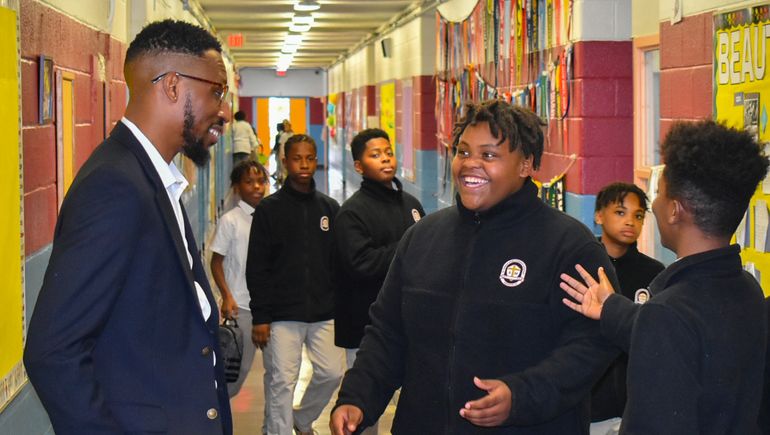During this summer, a team of students from MIT embarked on a journey to the sou …
Opportunity Knocks and Stays Put: Evaluating the Successes and Flaws of DC’s Private School Voucher Program
Jennifer Livingstone

The St. Thomas More Catholic Academy in Washington, D.C. is famously known as the “heart of Fourth Street” because of its emphasis on building a safe, welcoming, and close-knit community.
Families who live across the street from the school may mistakenly believe that they cannot afford the $8,600 annual tuition for their children to attend. However, Principal Gerald Smith Jr. believes there is a good chance they can. This is because they may be eligible for funding from the D.C. Opportunity Scholarship Program, which is the only private school voucher program in the country that receives federal funds.
St. Thomas More Catholic Academy has a longstanding relationship with the voucher program and has a high participation rate among its students. Approximately 90% of the school’s 168 students benefit from the scholarship program, which provides a maximum of $10,713 in tuition assistance for elementary and middle school grades.
Principal Smith expresses his joy when families realize they have the opportunity to send their children to the school. He believes that by providing an inclusive space, the school can foster character virtues, values, and love in students who may have experienced troubled situations.
The school employs 25 staff members, including a full-time counselor and two special educators. It also partners with nearby universities to provide educational and health services. For example, students from Georgetown University School of Medicine teach anatomy and physiology lessons and offer preventative health services.
Principal Smith acknowledges the challenges they have faced but remains committed to making a real change in the community. He believes that the scholarship program plays a vital role in supporting students who may otherwise be overlooked.
We’ve done a lot of amazing things not without struggle, but we’re cultivating real change.
Gerald Smith Jr.
Principal of St. Thomas More Catholic Academy
In the D.C. Opportunity Scholarship Program, 18 out of the 40 participating private schools are Catholic schools under the Roman Catholic Archdiocese of Washington. Since the program’s launch in 2004, all Catholic schools in the city have participated and accepted scholarship students, according to Brian Radziwill, the director for government and grant programs with the archdiocese.
While Radziwill cannot provide specific data on the number of participating students in the archdiocese, he states that more than half of the D.C. scholarship recipients attend a Catholic school. In addition to the D.C. voucher program, the archdiocese allocates $6.2 million annually in tuition assistance across its five counties in Maryland and the District of Columbia. This is in addition to the BOOST program, a state-run, state-funded private school scholarship program in Maryland.
However, the funding received is still insufficient to meet the estimated $25 million in total financial need across the D.C. Archdiocese, according to Radziwill.
Sometimes, St. Thomas More Catholic Academy is unable to enroll interested students due to their families narrowly exceeding the income cap, lacking resources, or not being able to submit the annual application.
The program has a high demand for funding, but it is not always available, as Principal Smith acknowledges.
Since its inception in 2004, the D.C. scholarship program has received approximately 46,000 applications, resulting in around 11,800 students being awarded scholarships, according to Serving Our Children, the nonprofit organization that administers the program.
How students are performing
One recurring question regarding the program is whether it leads to improved student outcomes. Despite being one of the most studied school voucher programs in the country, the answer depends on the specific metric being analyzed.
In a comprehensive analysis published in 2019 by the U.S. Department of Education’s Institute of Education Sciences, various outcomes, including reading and math achievement, chronic absenteeism, and parent and student satisfaction, were examined.
The study analyzed the three-year outcomes of applicants from 2012, 2013, and 2014, both for students offered scholarships and those who were not. Approximately 25% of the students offered scholarships did not use them.
The study applied a rigorous evaluation methodology, comparing the outcomes of the two groups of students. This involved administering the same assessments, collecting consistent data on attendance and parent satisfaction, and ensuring comparable conditions.
The impact of accepting a voucher on academic achievement in these programs is on par with or worse than the learning loss caused by Hurricane Katrina and the COVID-19 pandemic.
The National Coalition for Public Education
In an April 18 letter to members of Congress
In terms of academic outcomes, the study found no statistically significant differences in reading or math achievement three years after the students applied to the program. Surprisingly, students who received scholarships, regardless of whether they used them, scored 1.6 percentile points lower in reading compared to students who did not receive scholarships. However, scholarship recipients scored 0.1 percentile points higher in math.
Further examination of the performance of students who actually used the scholarships showed that they scored 2.1 percentile points lower in reading and 0.2 percentile points higher in math compared to the control group.
Opponents of vouchers often cite this data as evidence that taxpayer-funded private school tuition programs do not significantly benefit students. The National Coalition for Public Education expressed their concerns about the poor performance of voucher recipients in various locations, including Washington, D.C.
In contrast, local officials attribute the funding provided by the scholarship program to positive changes in teacher retention, student enrollment, public charter expansion, and academic achievement among traditional public schools and charter schools.
The improvement in 4th grade reading scores on the 2022 National Assessment of Educational Progress is one example. In 2022, 49% of D.C.’s public school students scored at or above a basic level in reading, which is an increase from 28% in 1998.
D.C.’s 4th grade reading NAEP scores improve over two decades

